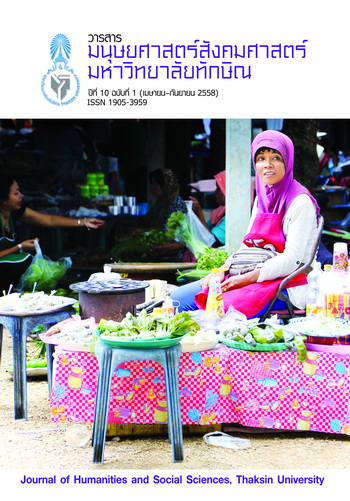การพัฒนารูปแบบสังคมร่มเย็นเป็นสุขของชุมชน โดยใช้ศาสนาเป็นฐานในจังหวัดพระนครศรีอยุธยา
คำสำคัญ:
-บทคัดย่อ
การวิจัยครั้งนี้เป็นการวิจัยและพัฒนา มีวัตถุประสงค์ 1) เพื่อศึกษาสภาพปัจจุบัน และความต้องการสังคมร่มเย็นเป็นสุขของชุมชนโดยใช้ศาสนาเป็นฐานในจังหวัด พระนครศรีอยุธยา 2) เพื่อพัฒนารูปแบบสังคมร่มเย็นเป็นสุขของชุมชนโดยใช้ศาสนา เป็นฐานในจังหวัดพระนครศรีอยุธยา 3) เพื่อทดลองใช้รูปแบบสังคมร่มเย็นเป็นสุขของ ชุมชนโดยใช้ศาสนาเป็นฐานในจังหวัดพระนครศรีอยุธยา 4) เพื่อประเมินรูปแบบและ ถอดบทเรียนสังคมร่มเย็นเป็นสุขของชุมชนโดยใช้ศาสนาเป็นฐานในจังหวัดพระนคร ศรีอยุธยา กลุ่มตัวอย่างในการศึกษาสภาพปัจจุบันและความต้องการเป็นประชากร จาก 16 อำเภอ ในจังหวัดพระนครศรีอยุธยา จำนวน 400 คน ใช้การสุ่มแบบชั้นภูมิ ตามสัดส่วน เก็บรวบรวมข้อมูลเชิงปริมาณด้วยแบบสอบถาม และเก็บรวบรวมข้อมูล เชิงคุณภาพจากการสัมภาษณ์ระดับลึก (In-depth interview) ผู้มีส่วนได้ส่วนเสียใน จังหวัดพระนครศรีอยุธยา 10 คน โดยการเลือกแบบเฉพาะเจาะจง (Purposive selection) ประชากรกลุ่ม เป้าหมายในการทดลองใช้รูปแบบ คือ ผู้เข้าร่วมกิจกรรมอบรม เสวนา กลุ่มย่อย และเวทีแลกเปลี่ยนเรียนรู้ ได้แก่ ผู้นำชุมชน แกนนำตัวแทนสถาบันศาสนา และสมาชิกชุมชน ในพื้นที่เป้าหมายสองชุมชนจากผลการศึกษานำร่อง (Pilot study) โดยการเลือกแบบเฉพาะเจาะจง จำนวน 30 คน และประชุมนำเสนอหัวหน้า ส่วนราชการ จำนวน 12 คน เครื่องมือที่ใช้ ได้แก่ แบบสังเกตและบันทึกพฤติกรรมการปฏิบัติ แบบทดสอบความรู้ก่อนและหลังการอบรม แบบประเมินผลการอบรม แบบประเมินความพึงพอใจ แบบประเมินผลการจัดประชุมนำเสนอ วิเคราะห์ข้อมูล เชิงปริมาณด้วยสถิติพื้นฐาน ได้แก่ ความถี่ ค่าร้อยละ ค่าเฉลี่ย ส่วนเบี่ยงเบนมาตรฐาน และทดสอบค่า t แบบ dependent วิเคราะห์ข้อมูลเชิงคุณภาพด้วยการวิเคราะห์เนื้อหา (Content analysis)
ผลการวิจัยพบว่า 1) กลุ่มตวั อย่างมีความคิดเห็นเกี่ยวกับสภาพปัจจุบันในอยู่ในระดับมาก โดยด้านวัฒนธรรมและศาสนาอยู่ในลำดับที่หนึ่งระดับมาก 2) การพัฒนา รูปแบบสังคมร่มเย็นเป็นสุขของชุมชนโดยใช้ศาสนาเป็นฐานในจังหวัดพระนคร ศรีอยุธยา ชื่อว่า DOCTRINE Model มี 8 องค์ประกอบ ได้แก่ D = Dogma (สมาชิก ชุมชนปฏิบัติตามคำสอนของศาสนา) O = Oneness (สมาชิกชุมชนมีความเป็นน้ำหนึ่ง ใจเดียวกัน) C = Coordination (การประสานงานที่ดีภายในชุมชนและเครือข่าย) T = Training & Learning Program (กิจกรรมการอบรมและเรียนรู้ที่สอดคล้องวิถีชีวิตชุมชน) R = Religions Centre (สถาบันศาสนาเป็นที่พึ่งทางจิตใจและเป็นศูนย์กลางชุมชน) I = Independence in Public Participation (สมาชิกชุมชนมีอิสระและมีส่วนร่วมกำหนด อนาคตชุมชน) N = News & Knowledge Distribution (การเผยแพร่ข่าวสารและความรู้ สู่ชุมชน) E = Equilibrium & Integrated Development (การพัฒนาชุมชนอย่างสมดุล และบูรณาการ) 3) ผลการทดลองใช้รูปแบบกับประชากรกลุ่มเป้าหมายในพื้นที่สอง ชุมชนผ่านกิจกรรมการอบรมมีผลสัมฤทธิ์การเรียนรู้หลังการอบรมสูงกว่าก่อนการ อบรมอย่างมีนัยสำคัญทางสถิติที่ระดับ .05 ส่วนความคิดเห็นของผู้เข้ารับการอบรม ที่มีต่อการประเมินผลการจัดอบรมอยู่ในระดับมาก โดยมีความเห็นว่าหัวข้อการอบรม เหมาะสมกับสถานการณ์ปัจจุบันและเนื้อหาสาระการอบรมเป็นความรู้ที่สามารถ นำไปใช้ในการดำเนินชีวิต 4) การประเมินรูปแบบและถอดบทเรียน พบว่า ผู้เข้าร่วม กิจกรรมมีความพึงพอใจในรูปแบบทุกด้านในระดับมาก และการถอดบทเรียน ผู้เข้าร่วม กิจกรรมในพื้นที่สองชุมชนมีการขับเคลื่อนกิจกรรมการเรียนรู้ การปฏิบัติ และจัดเวที แลกเปลี่ยนเรียนรู้ต่อเนื่องไปสู่สมาชิกชุมชนอื่นและในภาคีเครือข่าย
Development of green and happiness society model in community based on religions in Ayutthaya province
Manu Sandhivadhan
The study was conducted by using the Research and Development Method. The purposes of this research were to 1) study the current conditions and needs of green and happiness society in community based on religions in Ayutthaya province; 2) develop the green and happiness society model in community based on religions in Ayutthaya province; 3) experiment the green and happiness society model in community based on religions in Ayutthaya province; 4) Evaluate the green and happiness society model in community based on religions in Ayutthaya province and Complete its lesson learned. Samples for studying current conditions and needs became population in Ayutthaya province 400 persons with proportional stratified random sampling, and 10 stakeholders by purposive selection. Questionnaire was used for collecting quantitative data, and In-depth interview was used for collecting qualitative information. Target population for model experiment became resulted of pilot study, two communities with 30 persons by purposive selection such as leader, mainstay and public mind, implemented by training, focus group discussion, community of practice activities and final presentation to leader of government officers totally 12 persons. Observation Form, Pre-test & Post-test, Training Evaluation Form, Satisfaction Evaluation Form and Presentation Evaluation Form were used for collecting data and information. Frequency, Means, Standard deviation and t-test (dependent) were applied for analyzing quantitative data, and content analysis was applied for descripting qualitative information.
The findings of the research were as below; 1) the samples’ opinion regarding current conditions of Ayutthaya was high level in which culture and religions aspect was highest. 2) the development of green and happiness society model in community based on religions in Ayutthaya, DOCTRINE Model had 8 indicators, namely D (Dogma) O (Oneness) C (Coordination) T (Training & Learning Program) R (Religions Centre) I (Independent in Public Participation) N (News & Knowledge Distribution) E (Equilibrium & Integrated Development), which approved by the experts. 3) the experiment involved target population in two communities in Ayutthaya province and showed learning achievement after activity statistically significantly higher than before activity at the .05 level, and opinion to evaluation was good especially the subject matter aspect can be applied in real life. 4) the evaluation was satisfied with each aspect of the Model, and Lessons learned showed that target population in two communities in Ayutthaya province were applied learning, practice and community of practices activities of the Model to other members in communities including associate network.



